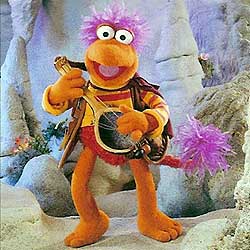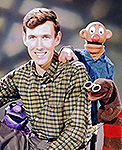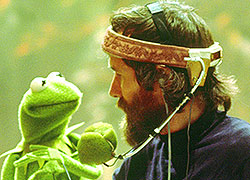- Joined
- Apr 11, 2002
- Messages
- 8,420
- Reaction score
- 3,480
Puppet exhibit descends on Delray
By Meghan Meyer, Palm Beach Post Staff Writer
Saturday, December 6, 2003
DELRAY BEACH -- A vibrantly painted blue and green Pharaoh and a bejeweled princess crying pearl tears stare down at visitors from the walls of the Cornell Museum's "World of Puppets" exhibit.
But the celebrity of the group, the one in a protective plastic case, looks like a simple stuffed animal. Four-foot tall Mokey, a purplish Muppet from Jim Henson's short-lived but much-loved television series Fraggle Rock, looks so inviting that visitors run up to touch her.
"The parents are, like, flipped over Mokey," Museum Director Gloria ReJune Adams said. "We find more adults touching the puppets than kids. Kids know they're not supposed to touch things in a museum."
Mokey had her heyday in the early 1980s, when the young parents who bring their children to the exhibit were growing up. She was one of pioneering puppeteer Jim Henson's Fraggles, benevolent, Muppet-like creatures who lived in Fraggle Rock's underground caverns with the industrious inch-tall Doozers, stealing vegetables from the giant Gorgs and seeking advice from the oracle, Marjory the Trash Heap.
The Fraggles taught children a moral lesson about cooperation, the environment and peaceful coexistence in each episode.
The artist and philosopher of the group, Mokey fits in perfectly with the Cornell Museum's mission, Adams said. Like the puppeteers who use bottle caps, bleach cans and broomsticks in their designs, Mokey used found objects to make jewelry. In the museum exhibit, she wears a pull tab from a soda can as a necklace pendant.
In the model workshop upstairs at the exhibit, visitors can see the work of Dave Goboff, who also specializes in found objects. A computer programmer by day, Goboff and his 7-year-old daughter perform short puppet shows in their spare time, using feather dusters, plates and other castoffs.
"A puppet can be anything," said Goboff, president of the Puppet Guild of South Florida. "It's the performance that makes it a puppet."
The Cornell Museum's exhibit shows off more than 200 puppets from nearly every continent: bawdy burlesque puppets from Burma; cuddly Kumquat puppets from a German children's show; a sheep farmer shadow puppet from legendary Australian puppeteer Richard Bradshaw. One room has a nine-foot-tall Queen of Hearts, Mad Hatter and other characters from Alice in Wonderland; in a glass case outside stands a four-inch tall winged fairy dressed in white lace.
The museum and Crest Theater next door have scheduled intermittent shows and educational activities until the end of the exhibit Jan. 11. This weekend the theater plays host to the internationally acclaimed Cashore Marionettes.
Adams admits she was skeptical at first of an art exhibit featuring puppets, children's toys. Her perspective changed as she put the exhibit together. Though the United State's most recognizable puppets star in children's shows, around the world, puppet shows are for adults. Other cultures treat puppets more delicately and revere puppeteers as artists.
"I have a new respect for puppeteers," Adams said. "We tried to show puppets are more than toys. They're art."
http://www.palmbeachpost.com/localnews/content/auto/epaper/editions/saturday/martin_stlucie_f31d6560b14d5096000f.html
By Meghan Meyer, Palm Beach Post Staff Writer
Saturday, December 6, 2003
DELRAY BEACH -- A vibrantly painted blue and green Pharaoh and a bejeweled princess crying pearl tears stare down at visitors from the walls of the Cornell Museum's "World of Puppets" exhibit.
But the celebrity of the group, the one in a protective plastic case, looks like a simple stuffed animal. Four-foot tall Mokey, a purplish Muppet from Jim Henson's short-lived but much-loved television series Fraggle Rock, looks so inviting that visitors run up to touch her.
"The parents are, like, flipped over Mokey," Museum Director Gloria ReJune Adams said. "We find more adults touching the puppets than kids. Kids know they're not supposed to touch things in a museum."
Mokey had her heyday in the early 1980s, when the young parents who bring their children to the exhibit were growing up. She was one of pioneering puppeteer Jim Henson's Fraggles, benevolent, Muppet-like creatures who lived in Fraggle Rock's underground caverns with the industrious inch-tall Doozers, stealing vegetables from the giant Gorgs and seeking advice from the oracle, Marjory the Trash Heap.
The Fraggles taught children a moral lesson about cooperation, the environment and peaceful coexistence in each episode.
The artist and philosopher of the group, Mokey fits in perfectly with the Cornell Museum's mission, Adams said. Like the puppeteers who use bottle caps, bleach cans and broomsticks in their designs, Mokey used found objects to make jewelry. In the museum exhibit, she wears a pull tab from a soda can as a necklace pendant.
In the model workshop upstairs at the exhibit, visitors can see the work of Dave Goboff, who also specializes in found objects. A computer programmer by day, Goboff and his 7-year-old daughter perform short puppet shows in their spare time, using feather dusters, plates and other castoffs.
"A puppet can be anything," said Goboff, president of the Puppet Guild of South Florida. "It's the performance that makes it a puppet."
The Cornell Museum's exhibit shows off more than 200 puppets from nearly every continent: bawdy burlesque puppets from Burma; cuddly Kumquat puppets from a German children's show; a sheep farmer shadow puppet from legendary Australian puppeteer Richard Bradshaw. One room has a nine-foot-tall Queen of Hearts, Mad Hatter and other characters from Alice in Wonderland; in a glass case outside stands a four-inch tall winged fairy dressed in white lace.
The museum and Crest Theater next door have scheduled intermittent shows and educational activities until the end of the exhibit Jan. 11. This weekend the theater plays host to the internationally acclaimed Cashore Marionettes.
Adams admits she was skeptical at first of an art exhibit featuring puppets, children's toys. Her perspective changed as she put the exhibit together. Though the United State's most recognizable puppets star in children's shows, around the world, puppet shows are for adults. Other cultures treat puppets more delicately and revere puppeteers as artists.
"I have a new respect for puppeteers," Adams said. "We tried to show puppets are more than toys. They're art."
http://www.palmbeachpost.com/localnews/content/auto/epaper/editions/saturday/martin_stlucie_f31d6560b14d5096000f.html

 Welcome to the Muppet Central Forum!
Welcome to the Muppet Central Forum!.jpg) Christmas Music
Christmas Music Macy's Thanksgiving Parade
Macy's Thanksgiving Parade Sesame Street debuts on Netflix
Sesame Street debuts on Netflix Back to the Rock Season 2
Back to the Rock Season 2 Sam and Friends Book
Sam and Friends Book Jim Henson Idea Man
Jim Henson Idea Man Bear arrives on Disney+
Bear arrives on Disney+

